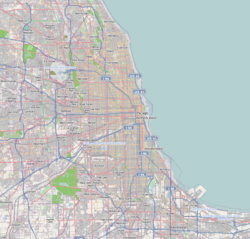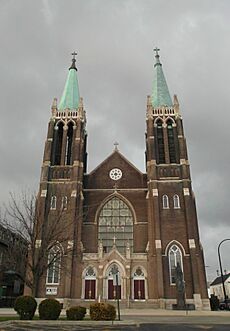Cicero, Illinois facts for kids
Quick facts for kids
Cicero, Illinois
|
|||
|---|---|---|---|
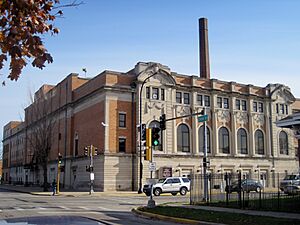
Chodl Auditorium
|
|||
|
|||
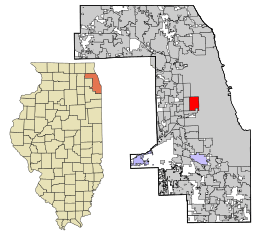
Location of Cicero in Cook County, Illinois
|
|||
| Country | |||
| State | Illinois | ||
| County | Cook | ||
| Township | Cicero | ||
| Incorporated | February 28, 1867 | ||
| Government | |||
| • Type | Council-manager | ||
| Area | |||
| • Total | 5.87 sq mi (15.19 km2) | ||
| • Land | 5.87 sq mi (15.19 km2) | ||
| • Water | 0.00 sq mi (0.00 km2) 0% | ||
| Elevation | 607 ft (185 m) | ||
| Population
(2020)
|
|||
| • Total | 85,268 | ||
| • Density | 14,538.45/sq mi (5,613.28/km2) | ||
| Standard of living (2011) | |||
| • Per capita income | $14,539 | ||
| • Median home value | $157,500 | ||
| ZIP Code |
60804
|
||
| Area code(s) | 708/464 | ||
| Geocode | 17-14351 | ||
| FIPS code | 17-14351 | ||
| GNIS feature ID | 2584746 | ||
Cicero is a town in Cook County, Illinois, United States. It is a suburb located near Chicago. In 2020, about 85,268 people lived there. This makes it the 11th most populated town in Illinois. The town is named after Marcus Tullius Cicero, a famous Roman speaker and leader. A large part of Cicero's population, over 89%, is of Hispanic background. This makes it the most Hispanic town in Illinois.
Contents
History of Cicero
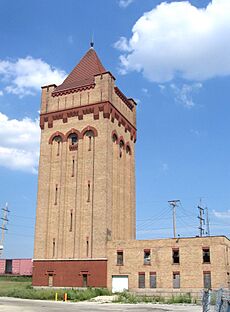
Cicero was once much larger than it is today. The area known as Cicero Township used to be six times its current size. Over time, parts of it became new cities like Oak Park and Berwyn. Other parts, such as Austin, joined the city of Chicago.
In 1911, an early airport called the Cicero Flying Field opened. It was used by famous pilots like Lincoln Beachey before World War I. The airport closed in 1916.
A well-known figure named Al Capone moved to Cicero to avoid the Chicago police. In 1924, the local elections in Cicero were very troubled. Some groups tried to influence the election results, which led to violence.
In 1951, there was a difficult time in Cicero. A Black family, led by Harvey Clark Jr., tried to move into an apartment in an all-white area. This led to a large protest and unrest. About 4,000 people attacked and burned the apartment building. The governor, Adlai E. Stevenson, had to call in the Illinois National Guard to help. The Clark family moved away, and the building was boarded up. This event in Cicero was criticized around the world.
In the mid-1960s, Cicero was considered for civil rights marches. At that time, Cicero had rules that made it difficult for African Americans to live in the city. Leaders like Martin Luther King Jr. and other groups were marching against unfair housing and school rules in Chicago and its suburbs. These marches helped gain support for the Civil Rights Act of 1968. This new law made it illegal to discriminate in private housing.
The 1980s and 1990s saw many Hispanic people move to Cicero. Most of them were from Mexico and Central America. Cicero used to be known as a Czech town. Now, many of the old European-style shops on 22nd Street (now Cermak Road) have been replaced by Spanish-named businesses. Cicero also has a small Black community.
Recently, Cicero's business areas have grown. Many new shopping centers and large stores have opened. New homes are also being built in the town.
Cicero has had issues with government problems in the past. In 2002, a former town leader, Betty Loren-Maltese, was found to have misused town money. Because of these past issues, Cicero is often not considered to join Chicago.
Geography of Cicero
Cicero covers an area of about 5.87 square miles (15.19 square kilometers). All of this area is land. In the past, Cicero was much larger. It stretched from Harlem Avenue to Western Avenue and Pershing Road to North Avenue. However, much of this land was later added to Chicago.
Cicero's Climate
|
||||||||||||||||||||||||||||||||||||||||||||||||||||||||||||||||||||||||||||||||||||||||||||||||
People of Cicero (Demographics)
| Historical population | |||
|---|---|---|---|
| Census | Pop. | %± | |
| 1860 | 1,272 | — | |
| 1870 | 1,545 | 21.5% | |
| 1880 | 5,182 | 235.4% | |
| 1890 | 10,204 | 96.9% | |
| 1900 | 16,310 | 59.8% | |
| 1910 | 14,557 | −10.7% | |
| 1920 | 44,995 | 209.1% | |
| 1930 | 66,602 | 48.0% | |
| 1940 | 64,712 | −2.8% | |
| 1950 | 67,544 | 4.4% | |
| 1960 | 69,130 | 2.3% | |
| 1970 | 67,058 | −3.0% | |
| 1980 | 61,232 | −8.7% | |
| 1990 | 67,436 | 10.1% | |
| 2000 | 85,616 | 27.0% | |
| 2010 | 83,895 | −2.0% | |
| 2020 | 85,268 | 1.6% | |
| U.S. Decennial Census 2010 2020 |
|||
In 2020, Cicero had 85,268 people living there. There were 22,698 households and 17,508 families. The town had about 14,538 people per square mile.
The people living in Cicero came from many different backgrounds:
- 19.22% White
- 3.72% African American
- 4.26% Native American
- 0.59% Asian
- 0.04% Pacific Islander
- 46.86% from other races
- 25.30% from two or more races
A large majority, 89.00%, of the population was Hispanic or Latino.
Out of all households, 45.5% had children under 18. About 47.83% were married couples. The average household had 4.06 people.
The average age in Cicero was 31.7 years. About 28.0% of the people were under 18.
The median income for a household was $53,726. For a family, it was $56,632. The average income per person was $20,040. About 13.8% of the population lived below the poverty line.
| Race / Ethnicity (NH = Non-Hispanic) | Pop 2000 | Pop 2010 | Pop 2020 | % 2000 | % 2010 | % 2020 |
|---|---|---|---|---|---|---|
| White alone (NH) | 16,787 | 7,696 | 5,332 | 19.61% | 9.17% | 6.25% |
| Black or African American alone (NH) | 674 | 2,690 | 2,870 | 0.79% | 3.21% | 3.37% |
| Native American or Alaska Native alone (NH) | 139 | 56 | 71 | 0.16% | 0.07% | 0.08% |
| Asian alone (NH) | 771 | 467 | 456 | 0.90% | 0.56% | 0.53% |
| Pacific Islander alone (NH) | 13 | 26 | 14 | 0.02% | 0.03% | 0.02% |
| Other race alone (NH) | 64 | 90 | 162 | 0.07% | 0.11% | 0.19% |
| Mixed race or Multiracial (NH) | 869 | 257 | 473 | 1.01% | 0.31% | 0.55% |
| Hispanic or Latino (any race) | 66,299 | 72,609 | 75,890 | 77.44% | 86.55% | 89.00% |
| Total | 85,616 | 83,891 | 85,268 | 100.00% | 100.00% | 100.00% |
In 2011, about half of the homes were owned, and half were rented. The average age of homes was over 66 years.
Cicero has been a town with many factories. In 1999, a quarter of the city had one of the largest groups of factories in the world. More than 150 factories produced things like electronics, sugar, printing presses, and steel.
Arts and Culture in Cicero
- St. Mary of Czestochowa is a beautiful church built in the Polish Cathedral style. It has a sculpture of Christ the King by a famous artist, Professor Czesław Dźwigaj.
- J. Sterling Morton High School, East Campus, also known as Morton East High School, was built in 1894. The original school burned down in 1924, and the current building was then built.
- Chodl Auditorium is inside Morton East High School. It was built in 1924 and finished in 1927. It is one of the largest non-commercial theaters in the Chicago area. It is also listed on the National Register of Historic Places.
- The Hawthorne Works Tower is one of the last parts of a huge factory that used to be in Cicero. It is now behind the Hawthorne Works Shopping Center.
- The Chicagoland Sports Hall of Fame is also located in Cicero.
Cicero has two racetracks on its south side. Hawthorne Race Course is a horse racing track that is still open. North of it was Chicago Motor Speedway at Sportsman's Park. This was also a horse racing track for many years. It is now closed and has been taken down. A Walmart and facilities for the Wirtz Beverage Group are now on that land.
Education in Cicero
Cicero has its own school district, Cicero Elementary School District 99. It has 16 schools, making it one of the largest public school districts outside of Chicago. Younger students attend various elementary schools. Older students go to Unity Junior High, which is one of the biggest middle schools in the country. High school students attend Morton East High School.
The Roman Catholic Archdiocese of Chicago runs two schools for younger students in Cicero: Our Lady of Charity School and St. Frances of Rome School.
From 1927 to 1972, Timothy Christian School was located in Cicero.
Cicero is also home to Morton College, which is a college for higher education.
Transportation in Cicero
Cicero has two main railroad lines: the BNSF Railway and the Belt Line Railroad. For public transport, Metra's BNSF Line has a stop at the Cicero station. This station is currently being rebuilt and made larger. The CTA Pink Line also serves Cicero. Its 54th/Cermak terminal and Cicero station are in the town. Many Pace and CTA bus routes also run through Cicero.
Fire Department
The Cicero Fire Department (CFD) has 97 full-time firefighters. They work out of three fire stations in the town.
Notable People from Cicero
- Felix Biestek (1912–1994), a priest and professor.
- Al Capone (1899–1947), a well-known figure who lived in Cicero.
- JoBe Cerny (born 1947), an actor who is the voice of the Pillsbury Doughboy.
- Joe Mantegna (born 1947), an award-winning actor, writer, and director.
- Erika Sánchez (born 1983/1984), a poet and writer.
- Lee Corso (born 1935), a former football coach and TV personality.
- Donald F. White (1908–2002), an architect and engineer.
See also
 In Spanish: Cícero (Illinois) para niños
In Spanish: Cícero (Illinois) para niños




